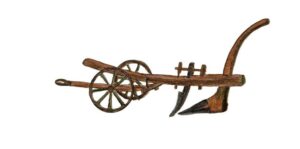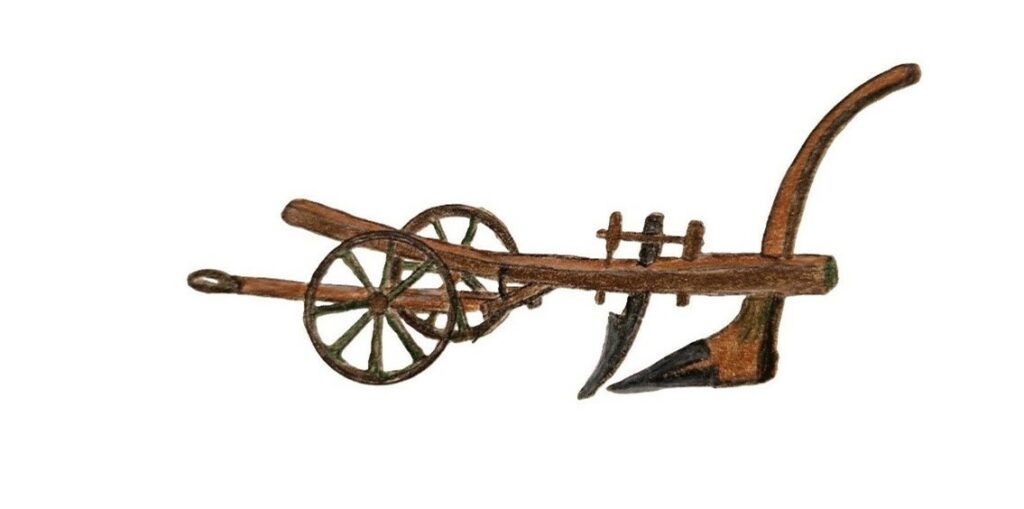Introduction and Development of the Plough in Britain – Romans and Vikings
By David Selin
In the first article, we traced the early evolution of the plough—from simple scratch tools of the Mesolithic era to the more robust ards and early field systems of the Iron Age. This second article picks up the story as Britain enters the Roman period, a time of sweeping change and innovation.
In 54 BC, Caesar landed five legions and two thousand cavalry in Kent, crossed the Thames, and captured the king’s stronghold. The British sued for peace, supplied hostages, and paid tribute to Rome. In 43 AD, Emperor Claudius sent fifty thousand men under General Aulus Plautius to conquer Britain. By 51 AD, Britain from Wales to York was a Roman province.
Roman occupation introduced slave-manned plantations of 400 to 650 acres, centred upon stone villas. Similar plantations were worked by peasants, or serfs, who cultivated their own plots and those of their lord.
The rich farmlands bordering the Fens provided grain for the Roman legions of the North. The grain was transported along the Fen’s natural waterways and on canals constructed by the Romans.
The Romans introduced both agricultural engineering techniques and improved tools to Britain. Agriculture benefited from Roman irrigation systems, wells, scythes and large sickles, and the more scientific application of fertiliser. The Roman plough, the Aratrum, improved on the simple ard by adding an iron tip to the share point and an iron coulter in front of the share. A later addition of a flat soil-turning wooden mouldboards and wheels rendered the new plough sufficient, although limited for the larger farming required by the Roman legion.
The Romans also introduced fruits and vegetables to British agriculture: these included peas, cabbages, turnips, parsnips and fruits supplementing the Iron Age crops of barley, wheat, flax, and vetch.
Following the withdrawal of Roman forces around 410 AD, the Saxons first invaded Britain. Alongside the Angles and Jutes, collectively referred to as Anglo-Saxons, they began to settle in Britain. This event signalled the commencement of the Anglo-Saxon period, which endured for several centuries.
As populations increased and settlements expanded, the need to cultivate more difficult terrains led to improvements in the mouldboard plough. Better iron coulters and shares were developed, and an iron-clad mouldboard was added to enhance durability and ploughs. These ploughs required up to eight oxen to pull them and three people to manage the process: a skilled ploughman and two individuals to guide and manage the oxen, which moved at a slow pace.
The introduction of the heavy plough facilitated agricultural development in areas with dense, clay-rich soils, subsequently enhancing productivity and expanding arable land..
The Danes arrived much later during the Viking Age. Their first major invasion occurred in 865 AD with the “Great Heathen Army,” which aimed to conquer and settle in England. While the Saxons established the early foundations of English culture and governance, the Danes brought major influence during their time, particularly in regions like the Danelaw.
The Normans Conquest took place in 1066, led by William the Conqueror. The Normans, descendants of Vikings who had settled in Normandy, France, launched a successful invasion and established Norman rule in England.

There is little evidence that there were any further innovations in plough design since the heavy plough. However, pressures on farming continuously needed better tools.
Traditional ploughs were heavy and required significant effort to operate. Farmers needed a lighter, more efficient design to reduce the physical strain on both animals and workers. The Agricultural Revolution brought an increased demand for productivity and cost-effectiveness. Thus, a plough capable of mass production and using fewer resources became highly desirable.
Traditional ploughs were heavy and required significant effort to operate. Farmers needed a lighter, more efficient design to reduce the physical strain on both animals and workers. The Agricultural Revolution brought an increased demand for productivity and cost-effectiveness. Thus, a plough capable of mass production and using fewer resources became highly desirable.
From Roman innovation to Viking refinement, the plough’s transformation during this period reflects the broader social and technological shifts that reshaped Britain. The introduction of iron components, the development of the heavy plough, and the expansion of cultivated land all point to the increasing importance of agriculture in supporting growing populations and organised settlements. These advancements laid the groundwork for the agricultural changes still to come, as rising demands for efficiency and productivity would eventually spark the innovations of the Agricultural Revolution. In the final article, we’ll explore how the plough continued to evolve in response to those pressures—and how it helped shape the modern agricultural world.
